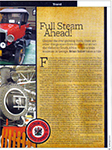Full steam ahead |
 |
<<Click to see original |
Despite the ever growing-hype, there are, it appears, other things apart from football this year to attract the visitor to South Africa…as Brian Salter has been finding out
For those of us who are not particularly enamoured with 'The Beautiful Game' (and believe it or not, there are some of us around!) the very mention of South Africa stirs the subconscious into thinking of all kinds of other things – Cape Town's Table Top Mountain, the myriad wildlife reserves, the abundant flora, and the beautiful multi-coloured birds; but apart from train-spotting aficionados, I suspect not a lot of people would put a train museum near the top of their wish list of must-see attractions in this huge country. Which could well be a pity because …
I have visited train museums in a number of countries, but never before had I come across anything like the Outeniqua Transport Museum in George - the largest town on the world-famous 'Garden Route', nestling beneath the magnificent Outeniqua Mountain range. (Outeniqua, we are told, means 'man laden with honey'.)
George lies in a central portion of the Western Cape, almost midway between Cape Town and Port Elizabeth, and one of its claims to fame is that it has the last remaining continually-operated passenger steam train in Africa - quaintly known as the Outeniqua Choo Tjoe.
The railway was fully completed in 1928, and was declared an officially preserved railway in 1992, carrying about 40,000 passengers per year at the time. A decade later, it carried 115,000 passengers per year, 70% of whom were foreign tourists. That is, until the disastrous flooding of 2006 when large stretches of the line east of George to Knysna were washed away. Now trains run only between George and Mossel Bay to the west.
The ride lasts about an hour and on leaving George the Choo Tjoe offers its passengers a picturesque 52-kilometre journey, travelling through beautiful farmlands before descending to the crossing at the Gwaing River Gorge. A few kilometres further on it crosses the Maalgaten River by means of an impressive four-pillar steel bridge spanning the gorge high above the riverbed. After the Outeniqua siding, the line begins its descent to the sea; as the train twists around a large horseshoe bend, the hillsides fall away dramatically and the view of the Indian Ocean, with its foaming waves crashing on to the seemingly endless beach, is breath taking.
For those 'in the know', the trains are usually pulled by Class 19D steam locomotives, of 4-8-2 wheel arrangement with Vanderbilt-like "torpedo" tenders, although the task is occasionally handled by Class 24 steam engines. When tinder dry conditions in the summer increase the risk of wildfires, diesel locomotives (Class 32s) have to be used instead.
But to most of the tourists, what class of steam locomotive is used is perhaps somewhat irrelevant. Irrelevant, that is, until they enter the museum situated beside the station. It is a transport museum that has to be the equal of the very best in the world.
Surely this must be the only museum that houses not just steam trains (13 in all), but also a collection of over 200 old cars, vintage tractors, fire engines, a stage coach, a 100-year old hearse … and that's not forgetting the largest 'HO'-gauge model railway in the southern hemisphere, a display of model aircraft, a corner devoted to lighthouses… nor the reconstructed station building, or the collections of loco number plates and makers plates…. The list just goes on and on.
Pride of place goes to one of the coaches of the Royal Train used by the then-Princesses Elizabeth and Margaret on their tour of 1947. Also on display is the Emil Kessler - Johannesburg’s first steam locomotive, as well as Paul Kruger's coach and private saloons. (It was Paul Kruger who gained international renown as the face of Boer resistance against the British during the Second Boer War of 1899-1902, and who later became State President of the South African Republic – Transvaal.)
And to put everything into context, you will find a comprehensive photo gallery depicting some of the most breathtaking photos of South African steam, together with poetry relating to train travel, crockery and cutlery previously used on main line trains and in station restaurants.
It's not every museum that can lay claim to having on display something for everyone; but seeing the faces of family members visiting the Outeniqua Choo Tjoe with its fabled museum, surely this one deserves that accolade.
You can fly to George from Johannesburg or Cape Town, or drive there on excellent roads from Cape Town in about five hours through spectacular scenery and along the route of the longest vineyard trail in the world, which is also famous for its many ostrich farms. Entry to the museum is R20 (AED6) for adults and half price for children under 12 yrs.
